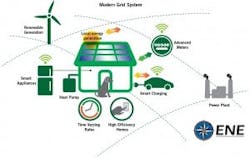What if We Used Electricity Instead of Fossil Fuels for Buildings and Cars? Here’s a Plan…
Released Feb. 3 by Environment Northeast, the national framework starts with successes in the Northeast – and advances them – in a nationwide mission to use electricity, rather than conventional fossil fuels, to heat buildings and power cars.
This electric energy system also would operate closer to home – or even in the home – as consumers increasingly adopt rooftop solar, electric vehicles and cloud-based energy management systems.
“The system we envision gives consumers greater control over their energy bills, provides significant economic benefit and achieves deep reductions in carbon emissions,” said Daniel Sosland, ENE’s president and CEO.
Modernizing the grid could decrease carbon dioxide emissions 75 percent by 2050, ENE said. It proposes four main pathways.
- Electrify buildings and transportation
- Modernize the grid
- Develop clean electric supply
- Maximize energy efficiency
To put its plan in perspective, ENE says that we would reduce greenhouse gas emissions 50 percent if we could magically replace fossil fuels today with electricity for vehicles and buildings. Add more renewables to the grid and the figure rises to 75 percent, under ENE’s vision.
The approach would ultimately save money too, ENE says. It is about 70 percent cheaper to operate electric vehicles and high efficiency electric heating technologies than traditional fossil-fueled counterparts, according to the report, which outlines the strategy: “EnergyVision: A Pathway to a Modern, Sustainable, Low Carbon Economic and Environmental Future.”
In developing strategies to realize the plan, EnergyVision looks to the Northeast, where a cap and trade program, the Regional Greenhouse Gas Initiative, has helped fund energy efficiency programs. RGGI has nine participating states. A scorecard produced by the American Council for an Energy-Efficient Economy ranked six of the RGGI states in its top 10 for energy efficiency last year.
Flush with money for clean energy, the New England states, alone, have invested more than $3.3 billion in energy efficiency to save more than 124,000 GWh. The region has been able to defer – and maybe avoid – at least $416 million in planned transmission, ENE said. In all, the Northeast’s energy efficiency efforts are expected to deliver $19.5 billion dollars in economic benefits and avoid 51.3 million metric tons of carbon emissions.
Making the grid “renewable-ready” is a key part of the EneryVision plan, so that the power being used by cars and buildings is clean. This include changing the way we fund transmission improvements, which is skewed against “non-transmission alternatives” – such as energy efficiency and distributed energy, according to the ENE report.
It also requires a rethinking of how utilities earn profit – a much-discussed issue these days as distributed energy gains traction.
Distributed energy does not “fit neatly into the old rate of return model.” This creates financial uncertainty for utilities, which can discourage them from adopting smart grid approaches like time varying rates, load control and voltage regulation, the report said.
The grid also needs to be more multi-directional in design, the report said. It is now structured largely for electricity to flow in one direction: from a central power plant to the consumer. The new grid – where a home may produce and store energy and offer demand response – needs to allow power to easily flow in either direction.
The report comes at a time when states are positioning to spend billions of dollars on electric transmission lines, natural gas pipelines and other infrastructure.
EnergyVision proposes instead “a cultural shift in how we think about our energy system…No longer will our energy dollars be poured only into massive power stations and miles of wire. The new grid is centered on our homes and businesses, where users control energy use and improve energy efficiency; install smart appliances; generate electricity from solar and other distributed energy sources; plug in our cars; connect to community wind, solar, and cogeneration; and earn incentives for using power when the grid is most available.”
ENE sees a lot of work ahead, but it’s ready to get the plan rolling. “We are calling on state policymakers, regulators and utilities to act now on carbon reduction by preparing the power grid for increased distributed renewable generation and the large-scale adoption of electric vehicles and efficient electric heating,” said Jamie Howland, director of ENE’s Climate and Energy Analysis Center and lead author.
What will it take to make this cultural shift to establish a modern electric grid? Let us know what you think by joining the discussion on our LinkedIn Group, Energy Efficiency Markets.







